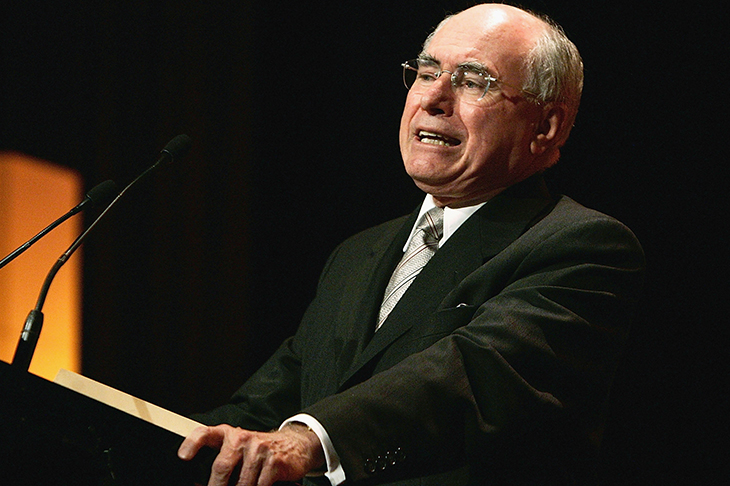At the very moment the federal Liberal party was having another debate over leadership I happened to be launching a book about one of the party’s founding fathers, Sir Joseph Carruthers.
Written by young historian Dr Zachary Gorman and reviewed in this magazine by Chris Berg earlier this year, the book is a rare specimen of modern historical writing, daring to paint an early-colonial figure in a positive light, against the prevailing intellectual fad of erasing history and tearing down statues.
They say history is written by the winners, but even when the Liberals are winning, all too often we seem willing to let Labor’s leftist comrades write the official black armband record. So well done Dr Gorman for bucking the trend.
The book is also timely because Carruthers’ life and work hold valuable lessons for the Liberal party today.
To me, three lessons in particular stand out.
The first and most important lesson, especially in the context of the current turmoil, is not a new one, but it bears learning and re-learning: the Liberal party is at its strongest when it balances and blends both its conservative and liberal traditions.
Carruthers lived and breathed this approach to politics. He was passionate about freedom and progress, but he was also a disciple of Edmund Burke, harbouring great respect for the values and institutions that have been the bedrock of history’s most successful and prosperous democratic societies.
It is often said that the Liberal party is a broad church, and there will always be a tension between conservatives and progressives, liberals and traditionalists. That tension, when healthy, is our greatest asset, driving assured progress, guided by the steady hand of accumulated wisdom.
However the same tension can also damage the party, as the events of the past week have shown.
Balancing and blending the liberal and conservative strains is not easy, but it is essential, especially for the party’s leaders. It means more than just begrudging compromise, or offering concessions to appease internal hostility.
When all you do is compromise, inevitably you end up compromised.
I use the words ‘balance and blend’ deliberately, because they were the words used by the greatest practitioner of Liberal politics in living memory: John Howard.
In Howard, we had a Prime Minister who genuinely respected the divergent views within the party, and channeled them into a unified platform that propelled his government to great success.
When people looked at the Howard Government, they did not see a rabble of warring tribes barely holding together. They saw a government that worked to draw the very best out of the wide-ranging views held within its ranks. If the Liberal party is to remain successful in Australian politics, its leaders and members must learn this lesson and put it into practice.
The second lesson Carruthers can teach is that we need to be activists. Carruthers grew up going to rallies with his dad. He was a masterful campaigner, and in the thick of the political battles of the day, he was everywhere. He boldly prosecuted the case, even venturing into enemy territory, addressing Labor Electoral League events to try to swing the crowd.
In short, he understood that his job was to persuade people that his ideas –Liberal ideas – were better ideas. And he succeeded. When you look at the left wing of politics, activism is in their blood. We would do well to rekindle our own activist instincts if we really want to shape our nation’s future in a meaningful and lasting way.
The third lesson is related to the second: if you want to be an activist, you have to have a positive message. Sir Joseph understood this. In the aftermath of Federation, there was a strong protest movement calling for state governments to downsize. He tapped into it, and he channeled it into a positive platform that led to great electoral success.
He didn’t define his politics by what he stood against, but by a distinct, alternative vision.
He made it known that the Liberals are the party for for self-respect, self-reliance and self help, in contrast to those who believe in collectivism, self-pity and identity politics. He heralded the Liberals as the party that governs for all, not just for niche interests groups.
And he worked to ensure equality of opportunity for all, because, as the son of a convict, he believed that in our young and free nation, anyone should be able to get ahead, no matter their circumstances.
His Liberal platform put citizens – not government – at the centre of society. He recognised the dignity and the potential of free men and women to build a great nation, to govern their own lives, and to rise to the challenges of living in community – rather than presuming that government can solve society’s ills at the stroke of a legislator’s pen.
In Carruthers’ political platform, you can see the unifying beliefs that still draw our broad church together. It is bold, it is positive, it is visionary and it is something that, to this day, should be at the heart of everything Liberal governments do.
There are many more lessons we can draw from Carruthers’ life – the necessity of pragmatism in politics, the value of maintaining warm relations with political opponents, and so on – all captured with great insight in Gorman’s biography, and I would encourage all in our party to read it for themselves.
Our party is at an important crossroads. There is no better time to get back to our roots, and draw inspiration from the life and work of the man who first put Liberal politics on the map in Australia.
Got something to add? Join the discussion and comment below.
Get 10 issues for just $10
Subscribe to The Spectator Australia today for the next 10 magazine issues, plus full online access, for just $10.
You might disagree with half of it, but you’ll enjoy reading all of it. Try your first month for free, then just $2 a week for the remainder of your first year.














Comments
Don't miss out
Join the conversation with other Spectator Australia readers. Subscribe to leave a comment.
SUBSCRIBEAlready a subscriber? Log in